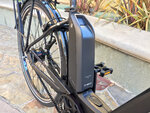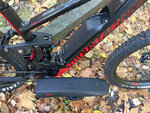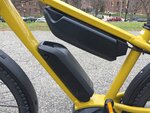Hi guys, I'm creating mini reviews for hardware like the Bosch PowerPack 500 that is shared across many electric bikes. This tactic allows me to go deeper, make updates in one place vs. having details spread out across reviews potentially going out of date, and it aggregates your excellent comments and input to be shared more effectively. There are variations in implementation and end product design, which I'll highlight back in the full ebike reviews on EBR.
The first Bosch PowerPack that I saw in the wild was on the Haibike XDURO AMT Pro way back in 2014. Technically, this was the smaller PowerPack 400. The casing and mount interface are the same as the high capacity 500, making it forwards compatible! That's been one of the big benefits of the PowerPack battery design all of these years, it has been easy to borrow, rent, and replace the battery and even upgrade older ebikes with high capacity packs. This battery is one of my favorites in the entire ebike space, offering several important benefits compared with competing battery designs including:




The Bosch PowerPack 500 is filled with 18650 sized lithium-ion cells from leading manufacturers like Samsung, Panasonic, Sony, and LG. I have asked the company several times which brand it uses most frequently, but I think they keep it a secret so that they can switch with demand increases. The big takeaway here is that they use high quality A and B rated cells that should provide more charge cycles and more stability. The cell configuration is 10 series, 4 parallel (10s4p) for both the PowerPack 400 and PowerPack 500 and PowerTube 500 with lower capacity 2500mAH cells in the 400 and 3800mAH cells in the 500. To maximize the lifespan of most lithium-ion batteries, it's best to store them in a cool dry location and avoid letting them fully discharge. Extreme temperatures can degrade the chemistry, you may notice that they do not offer maximum range on very cold days for example. Wait to charge a very hot or very cold battery and target the 20% to 80% fill to avoid stressing the cells. I have noticed that most ebike batteries come charged to roughly 50% on new ebikes and this may be the result of cost savings (since electricity isn't free) along with reducing stress by extended holds of 100% or 0%. Hybrid and electric cars utilize advanced battery management systems that maintain packs between 20% and 80% to reduce stress, and this is part of why they typically hold up so well for so long.
As an aside, I have seen threads and articles where people opened Bosch batteries to see the cells inside, but this is strongly discouraged because it could result in electrical shock, fire, and will void the warranty. If you have any issue with your PowerPack Bosch ebike battery, it is best to visit a Bosch certified dealer for help. They will diagnose the issue by plugging into a professional diagnostic tool, which will send an error and prompt them to recycle it and then warranty with a replacement or sell you a new one.
This review is still in the works, I invite your input below to make this as comprehensive as possible.
The first Bosch PowerPack that I saw in the wild was on the Haibike XDURO AMT Pro way back in 2014. Technically, this was the smaller PowerPack 400. The casing and mount interface are the same as the high capacity 500, making it forwards compatible! That's been one of the big benefits of the PowerPack battery design all of these years, it has been easy to borrow, rent, and replace the battery and even upgrade older ebikes with high capacity packs. This battery is one of my favorites in the entire ebike space, offering several important benefits compared with competing battery designs including:
- Backwards compatible to work with the PowerPack 400 interface, this makes it a great upgrade option for older ebikes
- Compact and lightweight design, at roughly 5.7lbs (2.58kg) this is one of the lightest ebike batteries for it's size and capacity, this is a wonderful benefit if you decide to bring a spare pack along in a bike trunk bag, pannier, or backpack to extend your ride. The PowerPack 500 is much more portable than the PowerTube 500 despite containing the same energy
- Durable plastic casing with integrated handle, it's easy to handle and transport and I've been told that Bosch even drop-tests their battery packs for durability, they have a great track record of safety
- Integrated 5-LED charge level indicator, even when the pack is not mounted to an electric bike, you can get a rough idea of how full it is
- Can be charged while mounted or independently, the charging port is very durable and uses a proprietary plug that won't get mixed up with other chargers
- Easier to find while traveling, since high capacity lithium-ion batteries cannot usually be moved on passenger planes, it's great that the PowerPack is so universally available to borrow, rent, or buy as a spare
- I have seen ebikes from Riese & Müller that utilized two PowerPack 500 batteries for extended range and even mixed and matched one PowerPack 500 with one PowerTube 500 and the Bosch system can handle this, the controller even balances the packs while discharging to reduce cycles on one battery over the other
- Can be charged with the standard fast 4 amp charger or a lighter, smaller 2 amp charger for travel situations, both are light, compact, and UL Certified
- All Bosch battery packs are UL Certified for safety and backed by a large, well established corporation
- Can require a bit of extra physical pressure to mount, listen for a click when mounting the PowerPack 500 to be sure it is securely mounted, note that the interface is adjustable so you can reduce rattling or make it easier to click on with help from your local Certified Bosch ebike dealer
- Usually positions weight higher up on bike frames than the internally mounted PowerTube design, may also take up space where a water bottle or other accessory could mount, I have seen some great designs from Moustache, Cannondale, and Trek that sink the PowerPack into the downtube to lower weight and free up frame space for accessories
- Not as beautiful as the internal battery packs that are hidden within the frame, the PowerPack only comes in black or black and gray and is usually partially visible on bike frames, some companies hide it with plastic covers, but the covers usually don't lock and can be easily misplaced or taken, other companies use stickers to help them match, but the stickers aren't always available after market so you'll be stuck with black if you ever replace the battery (you might want to try to swap the stickers)




The Bosch PowerPack 500 is filled with 18650 sized lithium-ion cells from leading manufacturers like Samsung, Panasonic, Sony, and LG. I have asked the company several times which brand it uses most frequently, but I think they keep it a secret so that they can switch with demand increases. The big takeaway here is that they use high quality A and B rated cells that should provide more charge cycles and more stability. The cell configuration is 10 series, 4 parallel (10s4p) for both the PowerPack 400 and PowerPack 500 and PowerTube 500 with lower capacity 2500mAH cells in the 400 and 3800mAH cells in the 500. To maximize the lifespan of most lithium-ion batteries, it's best to store them in a cool dry location and avoid letting them fully discharge. Extreme temperatures can degrade the chemistry, you may notice that they do not offer maximum range on very cold days for example. Wait to charge a very hot or very cold battery and target the 20% to 80% fill to avoid stressing the cells. I have noticed that most ebike batteries come charged to roughly 50% on new ebikes and this may be the result of cost savings (since electricity isn't free) along with reducing stress by extended holds of 100% or 0%. Hybrid and electric cars utilize advanced battery management systems that maintain packs between 20% and 80% to reduce stress, and this is part of why they typically hold up so well for so long.
As an aside, I have seen threads and articles where people opened Bosch batteries to see the cells inside, but this is strongly discouraged because it could result in electrical shock, fire, and will void the warranty. If you have any issue with your PowerPack Bosch ebike battery, it is best to visit a Bosch certified dealer for help. They will diagnose the issue by plugging into a professional diagnostic tool, which will send an error and prompt them to recycle it and then warranty with a replacement or sell you a new one.
This review is still in the works, I invite your input below to make this as comprehensive as possible.
Last edited:

